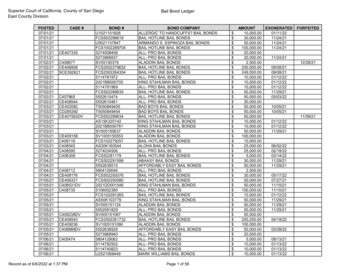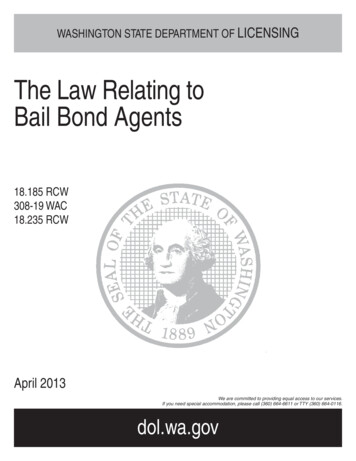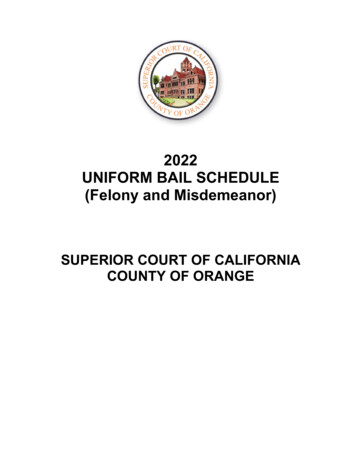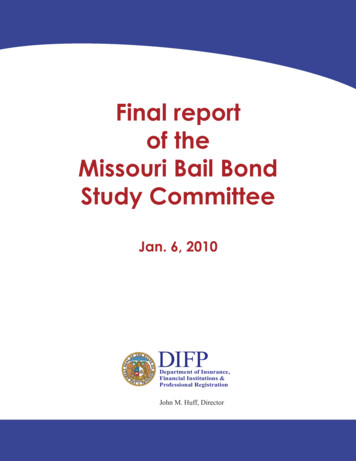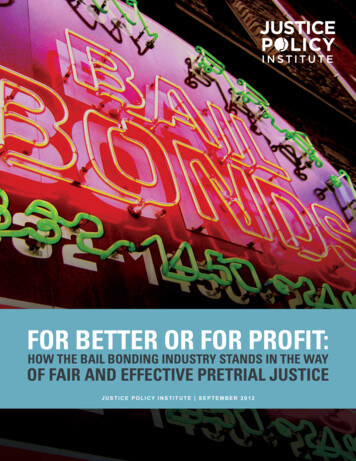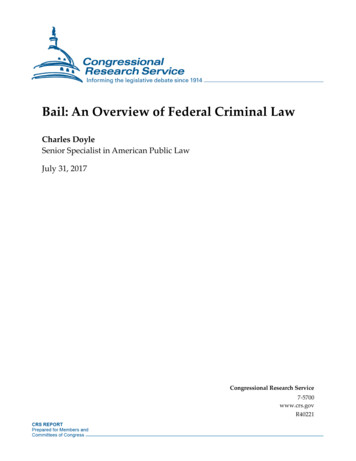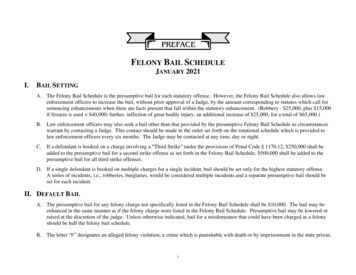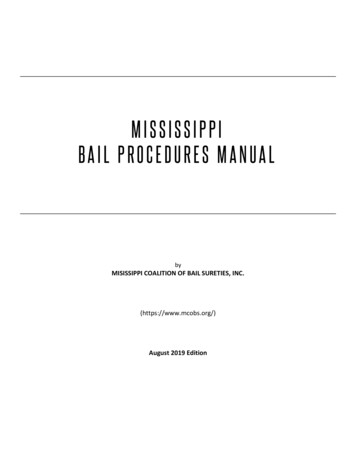
Transcription
Overview of Canadian Bail-in RegimeDecember 20180
Notice to InvestorsIt should be noted that regulators have significant discretion with respect to bank resolution and insolvency regimes and how regulators will exercise thatdiscretion will depend upon their understanding of the particular facts and circumstances at the relevant time, which may be complex and rapidlyevolving. This will result in substantial uncertainty with respect to recovery values and other economic and legal effects of those regimes on holders andbeneficial owners of securities in any particular resolution or insolvency. For a description of Canadian bank resolution powers and the risk factorsattaching to bail-in notes reference is made to http://www.rbc.com/investorrelations/ assets-custom/pdf/Bail-in-Disclosure.pdf.Nothing in this document shall be considered as an offer to sell or solicitation of an offer to buy any security or other instrument of RBC or any of itsaffiliates or as an inducement to enter into any investment activity, and no part of this document shall form the basis of or be relied upon in connectionwith any contract, commitment, or investment decision whatsoever. Offers to sell, sales, solicitation of offers to buy, or purchases of securities issued byRBC or any affiliate thereof may only be made or entered into pursuant to appropriate offering materials or a prospectus prepared and distributed inaccordance with the laws, regulations rules and market practices of the jurisdictions in which such offers or sales may be made. No person should usethis document or any part thereof as the basis for making a decision to purchase or sell any security at any time.This document is only being distributed to and is only directed at (i) persons who are outside the United Kingdom (ii) to investment professionals fallingwithin Article 19(5) of the Financial Services and Markets Act 2000 (Financial Promotion) Order 2005 (the “Order”) or (iii) high net worth entities, andother persons to whom it may lawfully be communicated, falling within Article 49(2)(a) to (d) of the Order (all such persons together being referred to as“Relevant Persons”). Royal Bank of Canada’s securities are only available to, and any invitation, offer or agreement to subscribe, purchase or otherwiseacquire such securities will be engaged in only with, Relevant Persons. Any person who is not a Relevant Person should not act or rely on this documentor any of its contents.Certain defined terms used in this presentation have the meanings indicated in Annex A.1
Caution Regarding Forward-Looking StatementsFrom time to time, we make written or oral forward-looking statements within the meaning of certain securities laws, including the “safe harbour”provisions of the United States Private Securities Litigation Reform Act of 1995 and any applicable Canadian securities legislation. We may makeforward-looking statements in this presentation, in filings with Canadian regulators or the Securities and Exchange Commission, in reports toshareholders and in other communications. Forward-looking statements in this presentation include, but are not limited to, statements relating to ourfinancial performance objectives, vision and strategic goals, the effects of bank resolution and insolvency regimes and our expectations with respect toTLAC requirements. The forward-looking information contained in this document is presented for the purpose of assisting the holders of our securitiesand financial analysts in understanding our financial position and results of operations as at and for the periods ended on the dates presented, as well asour financial performance objectives, vision and strategic goals, and may not be appropriate for other purposes. Forward-looking statements are typicallyidentified by words such as “believe”, “expect”, “foresee”, “forecast”, “anticipate”, “intend”, “estimate”, “goal”, “plan” and “project” and similar expressionsof future or conditional verbs such as “will”, “may”, “should”, “could” or “would”.By their very nature, forward-looking statements require us to make assumptions and are subject to inherent risks and uncertainties, which give rise to thepossibility that our predictions, forecasts, projections, expectations or conclusions will not prove to be accurate, that our assumptions may not be correctand that our financial performance objectives, vision and strategic goals will not be achieved. We caution readers not to place undue reliance on thesestatements as a number of risk factors could cause our actual results to differ materially from the expectations expressed in such forward-lookingstatements. These factors – many of which are beyond our control and the effects of which can be difficult to predict – include: credit, market, liquidity andfunding, insurance, operational, regulatory compliance, strategic, reputation, legal and regulatory environment, competitive and systemic risks and otherrisks discussed in the risk sections of our 2018 Annual Report including global uncertainty, elevated Canadian housing prices and householdindebtedness, information technology and cyber risk, regulatory changes, digital disruption and innovation, data and third party related risks, climatechange, the business and economic conditions in the geographic regions in which we operate, the effects of changes in government fiscal, monetary andother policies, tax risk and transparency, environmental and social risk and the significant regulator discretion with respect to bank resolution andinsolvency regimes, which will result in substantial uncertainty with respect to recovery values and other economic and legal effects of those regimes onholders and beneficial owners of securities in any particular resolution or insolvency.We caution that the foregoing list of risk factors is not exhaustive and other factors could also adversely affect our results. When relying on our forwardlooking statements to make decisions with respect to us, investors and others should carefully consider the foregoing factors and other uncertainties andpotential events. Material economic assumptions underlying the forward-looking statements contained in this presentation are set out in the Economic,market, and regulatory review and outlook section and for each business segment under the Strategic priorities and Outlook headings in our 2018 AnnualReport. Except as required by law, we do not undertake to update any forward-looking statement, whether written or oral, that may be made from time totime by us or on our behalf. Additional information about these and other factors can be found in the risk sections of our 2018 Annual Report. Informationcontained in or otherwise accessible through the websites mentioned does not form part of this presentation. All references in this presentation towebsites are inactive textual references and are for your information only.2
Key Features of the Canadian Bank Bail-in RegimeSingle Class of Term Debt Since September 23, 2018, Canadian bank term ( 400 days) senior unsecured debt that is subject to bail-in is a single classof debt1 and is not subordinated to another class of wholesale senior debt Only format of issuance of Canadian bank term senior unsecured debt2 after September 23, 2018Bail-in Debt Ranking in Liquidation – Equal to Deposits and Other Senior Liabilities Canadian bank term senior unsecured debt is not structurally, statutorily or contractually subordinated to another class ofsenior ination3ContractualSubordination3Separation of Liabilities Subject to Bail-in from sitsOpco Senior / Senior Preferred / Other SeniorLiabilitiesSeniorDebtSubjectto Bail-inHoldco Senior / Senior Non-preferredCapitalCapitalTLAC eligible senior debt1Ranks pari passu with other forms of senior debt, except as otherwise prescribed by law and subject to the exercise of bank resolution powersExcludes structured notes as defined in section 2(6) of the Bank Recapitalization (Bail-in) Conversion Regulations under the CDIC Act3 Jurisdictions highlighted are representative and not exhaustive. Indicates approach applicable to G-SIBs in the relevant jurisdictions.23
Key Features of the Canadian Bank Bail-in Regime (continued)No Creditor Worse Off Principle No Creditor Worse Off principle designed to ensure that bailed-in senior creditors should not incur greater losses throughresolution than liquidation Under the CDIC compensation regime, holders are entitled to receive, to the extent positive, the difference betweenliquidation and resolution value Because of the No Creditor Worse Off principle, recovery value would not depend solely on the value of the common sharesreceived in a bail-in conversion and would still factor in the liquidation value (liquidation value is required to be computedassuming no bail-in conversion occurs). Given the characteristics of Canadian bail-in debt, including the pari passu ranking inliquidation and absence of depositor preference and structural subordination, liquidation value would generally be expected tobe higher for a given amount of loss, if all else is equal, under the Canadian regime than would be the case under bailin/TLAC regimes in jurisdictions where some or all of these characteristics are not applicable.No Legislative or Administrative Prohibition Against Government Financial Assistance Regulatory intent is to use the bail-in tool to reduce government and taxpayer exposure, however, there is no statutoryprohibition against government financial assistanceStatutory Regime Unlike contractual regime of Canadian NVCC capital instruments, there is no set conversion multiplier Partial bail-in is permissible Senior debt might not be bailed-in even if NVCC instruments are convertedManagement Incentives to Recapitalize Early Potential dilution risk from equity conversion of NVCC capital provides management incentive to recapitalize the bank earlyParticipation in Equity – Post Resolution If bail-in is triggered, conversion into equity of the bank or an affiliate has the potential to result in realizable valueProtection for Senior Debt Holders Consistent with U.S., acceleration rights1 upon non-payment of principal or interest is allowed in Canada, but not in Europe2 Relative creditor hierarchy maintained through conversion formulas in Canadian bank resolution framework12Subject to 30 business day grace period and subject to bail-in conversion powers until repaid in fullExcluding UK4
RBC’s Approach to Meeting TLAC RequirementsNo Incremental Funding Needs We expect to meet TLAC requirements in advance of the November 1, 2021 compliance date simply by refinancing upcomingmaturities Rating agencies have adopted a forward-looking view, taking into account expected final TLAC builds based on rollover of allexisting long-term senior debt Accelerating issuance to support ratings profile is unnecessaryExpected build up of TLAC RWA ratio125.5%25.8%Expected build up of TLAC leverage ratio19.0%26%9.2%8.0%22.8%21.5% min18.7%6.6%6.75% min5.4%15.2%20189.1%20192020202120222023 201820192020202120222023 Cushion in Excess of TLAC Requirements Since this is a single class of debt and our liquidity needs are in excess of TLAC needs, our TLAC ratio is expected to be inexcess of minimum requirements As a result, a lower proportion of this single class of senior debt will have to be bailed-in for a given amount of loss1Based on static balance sheet, assuming rollover of existing long term debt into TLAC eligible new senior debt. Assumes bullet issuance. If all issuance was incallable format with no incentive to redeem, TLAC ratio would be 29% of RWA and 10% of leverage exposure. Holds other balance sheet components constant(RWA, Leverage Exposures, Outstanding Capital)5
Comparison with RBC Legacy Senior Long Term Debt1New Senior DebtIssuing EntityFormatRanking inLiquidationGoverning LawBail-in ProvisionOther ResolutionPowersParticipation inEquity - PostResolutionOperating companySenior unsecured (single class of debt)Pari passu with deposits and other senior liabilities2In accordance with local law or Canadian law, as applicableGoverned by Canadian law1NoBridge Bank Order, Vesting Order, Receivership OrderYes. Conversion to equity of the bank or anaffiliate allows participation in upside3, if anyAccelerationRights UponFailure to Pay P&IRatings4 (Moody’s,S&P, Fitch, DBRS)Legacy Senior DebtNoYesA2 / A / AA / AA (Low)Aa2 / AA- / AA / AARefers to senior long term debt issued prior to September 23, 2018Except as otherwise prescribed by law and subject to the exercise of bank resolution powers3 Assuming bail-in is triggered. If other resolution powers are exercised, debt holders could be exposed to losses in a manner similar to a write-down of their claims.4 Based on public announcements by the rating agencies. A credit rating is not a recommendation to buy, sell or hold securities, and it may be subject to revision orwithdrawal at any time by the assigning rating agency organization.26
Comparison Across JurisdictionsInstrumentTypeOpco SeniorHoldco SeniorHoldco SeniorHoldco Senior3Opco Non-PreferredSeniorRanking inLiquidationPari passu with depositsand other ipation in Conversion to equity ofEquity - Postthe bank or an affiliateresolutionallows participation inupside, if any1N/A2AccelerationRights UponFailure to PayP&IYesYesUncertain givenUncertain givenUncertain givenpossibility of writedown possibility of writedown possibility of writedownYesYesNo4Because of the No Creditor Worse Off principle, recovery value would not depend solely on the value of the common sharesreceived in a bail-in conversion and would still factor in the liquidation value (liquidation value is required to be computedassuming no bail-in conversion occurs). Given the characteristics of Canadian bail-in debt, including the pari passu ranking inliquidation and absence of depositor preference and structural subordination, liquidation value would generally be expected to behigher for a given amount of loss, if all else is equal, under the Canadian regime than would be the case under bail-in/TLACregimes in jurisdictions where some or all of these characteristics are not applicable.1Assuming only bail-in is triggered. If other resolution powers are exercised, debt holders could be exposed to losses in a manner similar to a write-down of their claims.No bail-in power. In resolution, debtholders could potentially receive partial recoveries (analogous to a write-down) or have their claims satisfied through the issuance of new securities(analogous to a bail-in conversion).3 Applicable in practice for G-SIBs’ issuance of non-capital bail-in debt.4 The terms of senior non-preferred do not include acceleration rights upon failure to pay principal and interest; however, there is no statutory restriction in this regard. Once resolutionproceedings are underway, holders may declare an event of default for failure to meet payment obligations.27
Summary of TLAC/Bail-in RegimeExcludedLiabilitiesTLAC Compliance DateNovember 1, 2021Scope of BanksD-SIBs as designated by OSFIInsured DepositsTLAC eligibilityRegulatory capital bail-in debt with remaining term to maturity 1 year3Min. requirementMinimum TLAC ratio of 21.5% of RWA and 6.75% of leverage exposureGrandfatheringYes, all senior instruments issued before implementation date of legislationSequencing andpreconditions1. Federal authorities bring bank into resolution2. Full conversion of bank’s NVCC instruments must occur prior to orconcurrently with bail-inScope of bail-ininstruments Only senior unsecured debt that is tradable and transferable Original term to maturity of 400 days or more1 Issued or renegotiated after the implementation of the final bail-in rule(September 23, 2018)Form of bail-inEquity ConversionDisclosure requirementsAll D-SIBs required to: Include specific disclosure related to the conversion power in anyagreement governing an eligible liability as well as any accompanyingoffering document Include a clause in the contractual provisions governing any eligibleliability through which investors provide express submission to theCanadian bail-in regime Provide continuous disclosure of TLAC ratios starting in Q1 2019UninsuredDeposits1Secured &CoveredShort Term DebtStructured Notes2DerivativeLiabilitiesOther Liabilities21.5% of RWABail in debtLong TermUnsecured DebtPrefs & Sub DebtNVCCCapital Providers(Equity) Bail-in is not the only path in Canada to resolve a failing bank. Canadian authorities have otherpowers, including “vesting order”, “receivership order”, “bridge bank resolution order” etc.The government retains full discretion to use other powers Conversion into equity under the Canadian bail-in regime has the potential to result in realizable value,potentially in excess of principal amount1Yankee CD’s with original term 400 days are in-scope of bail-inAs per definition of structured notes in section 2(6) of the Bank Recapitalization (Bail-in) Conversion Regulations under the CDIC Act3 Provided such bail-in debt meets certain other requirements28
Mechanics of the Bail-in ConversionWhen Can a Bail-in Occur? CDIC’s bail-in power is activated when the Superintendent of the Office of the Superintendent of Financial Institutionsdetermines the D-SIB has reached a point of non-viability, and the federal government, relying on a recommendation from theMinister of Finance, authorizes CDIC to take temporary control or ownership of the D-SIB NVCC capital instruments must be converted before or concurrently with bail-in debt CDIC has a number of tools to assist or resolve a failing institution, including bail-in, restructuring the bank, replacing itsdirectors, and using the bank’s existing employees and contractors to ensure the essential services of the bank aremaintained CDIC would use the tool that in its view is most appropriate in the situation with the goal of returning the bank to viabilityWhat are the Terms of Conversion? CDIC has discretion to determine the amount of bail-in instruments converted, the conversion formula, and timing, subject tothe following parameters:6.75% min– Adequate recapitalization must be a key consideration in determining the magnitude and rate of conversion– Order of conversion – CDIC can only convert bail-in debt if NVCC instruments and subordinate-ranking bail-in instrumentshave been or are concurrently being converted– Equal treatment – CDIC must convert equally ranking bail-in instruments in the same proportion and for the same numberof common shares per dollar of the converted claim– Relative creditor hierarchy – bail-in debt must be converted into more common shares per dollar than holders ofsubordinate-ranking bail-in and NVCC instruments that are converted Debt may only be converted to common shares of the Bank or any affiliate and may not be written down under the bail-inpowerNo Creditor Worse Off Principle CDIC would compensate a member institution’s holders of bail-in instruments that are converted out of the deposit insurancefund if they are made worse off as a result of the resolution actions by CDIC than they would have been if the bank wasliquidated or wound up– The amount of compensation would be based on CDIC’s estimate of the difference between the liquidation value of aninstrument (if the bank was wound up without being subject to resolution measures) and the resolution value of theinstrument9
Annex AGlossaryCDCertificate of depositCDICCanada Deposit Insurance CorporationD-SIBDomestic systemically important bankDBRSDBRS, Inc.G-SIBGlobal systemically important bankFitchFitch Ratings, Inc.HoldcoHolding CompanyMoody’sMoody’s Investors ServiceNVCCNon-viability contingent capitalOpCoOperating CompanyOSFIOffice of the Superintendent of FinancialInstitutionsP&IPrincipal and interestRWARisk-weighted assetsS&PS&P Global RatingsTLACTotal loss-absorbing capacityTSRTotal shareholder return10
Excludes structured notes as defined in section 2(6) of the Bank Recapitalization (Bail -in) Conversion Regulations under the CD IC Act. 3. Jurisdictions highlighted are representative and not exhaustive. Indicates approach applicable to G -SIBs in the relevant jurisdictions. Key Features of the Canadian Bank Bail -in Regime. Single Class of .

